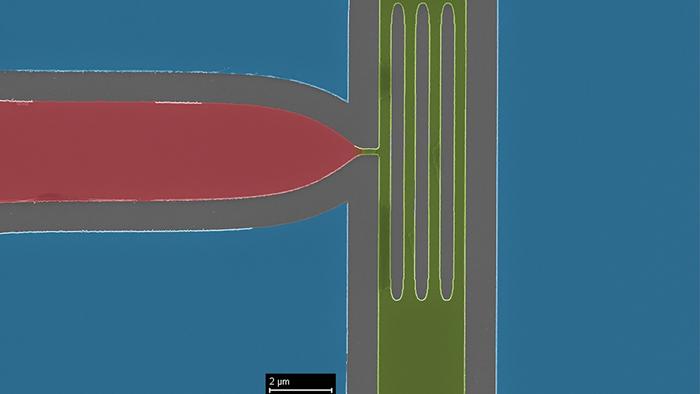Device could help facilitate the operation of new particle colliders, such as the Electron-Ion Collider.

Credit: (Image by Argonne National Laboratory.)
Device could help facilitate the operation of new particle colliders, such as the Electron-Ion Collider.
In particle colliders that reveal the hidden secrets of the tiniest constituents of our universe, minute particles leave behind extremely faint electrical traces when they are generated in enormous collisions. Some detectors in these facilities use superconductivity — a phenomenon in which electricity is carried with zero resistance at low temperatures — to function.
For scientists to more accurately observe the behavior of these particles, these weak electrical signals, or currents, need to be multiplied by an instrument capable of turning a faint electrical flicker into a real jolt.
Scientists at the U.S. Department of Energy’s (DOE) Argonne National Laboratory have developed a new device that acts as a “current multiplier.” This device, called a nanocryotron, is a prototype for a mechanism that could turn up a particle’s electrical signal high enough to a level where it temporarily turns off the superconductivity of the material, essentially creating a kind of on-off switch.
“This work is especially important for collider experiments, such as those that will be performed at the Electron-Ion Collider at Brookhaven National Laboratory.” — Argonne Distinguished Fellow and group leader Zein-Eddine Meziani
“We’re taking a small signal and using it to trigger an electric cascade,” said Tomas Polakovic, one of Argonne’s Maria Goeppert Mayer Fellows and an author of the study. “We’re going to funnel the very small current of these detectors into the switching device, which can be then used to switch a much bigger current.”
To prepare the nanocryotron for a collider experiment will take some more work because of the high magnetic fields involved. While today’s particle detectors can withstand magnetic fields of several tesla in strength, this switch’s performance degrades in high magnetic fields.
“Finding ways to make the device work in higher magnetic fields is key to incorporating it into a real experiment,” said Argonne graduate research assistant Timothy Draher, another author of the study.
To make this possible, the researchers plan to change the geometry of the material and introduce defects, or tiny holes. These defects will help researchers stabilize small superconducting vortices in the material, the movement of which can lead to an unanticipated disruption of superconductivity.
The nanocryotron was created by using electron beam lithography, a kind of stenciling technique that uses a beam of electrons to remove a polymer film to expose a particular region of interest. That region of interest is then etched using plasma ion etching.
“We basically just strip away the parts that are exposed, leaving behind the device that we want to use,” Draher said.
According to Argonne physicist Valentine Novosad, another author of the study, the new device also could serve as the basis for a kind of electronic logic circuitry.
“This work is especially important for collider experiments, such as those that will be performed at the Electron-Ion Collider at Brookhaven National Laboratory. There, superconducting nanowire detectors, positioned close to the beams, would require microelectronics immune to magnetic fields,” said Argonne Distinguished Fellow and group leader Zein-Eddine Meziani.
A paper based on the study, “Design and performance of parallel-channel nanocryotrons in magnetic fields,” appeared in the Dec. 18, 2023 edition of Applied Physics Letters. In addition to Draher, Zein-Eddine, Polakovic and Novosad, authors include Yi Li, John Pearson, Alan Dibos and Zhili Xiao.
The work was funded by DOE’s Office of Science, Office of Nuclear Physics. Work to perform reactive ion etching of the superconducting films in the experiment was carried out at the Center for Nanoscale Materials, a DOE User Facility.
About Argonne’s Center for Nanoscale Materials
The Center for Nanoscale Materials is one of the five DOE Nanoscale Science Research Centers, premier national user facilities for interdisciplinary research at the nanoscale supported by the DOE Office of Science. Together the NSRCs comprise a suite of complementary facilities that provide researchers with state-of-the-art capabilities to fabricate, process, characterize and model nanoscale materials, and constitute the largest infrastructure investment of the National Nanotechnology Initiative. The NSRCs are located at DOE’s Argonne, Brookhaven, Lawrence Berkeley, Oak Ridge, Sandia and Los Alamos National Laboratories. For more information about the DOE NSRCs, please visit https://science.osti.gov/User-Facilities/User-Facilities-at-a-Glance.
Argonne National Laboratory seeks solutions to pressing national problems in science and technology. The nation’s first national laboratory, Argonne conducts leading-edge basic and applied scientific research in virtually every scientific discipline. Argonne researchers work closely with researchers from hundreds of companies, universities, and federal, state and municipal agencies to help them solve their specific problems, advance America’s scientific leadership and prepare the nation for a better future. With employees from more than 60 nations, Argonne is managed by UChicago Argonne, LLC for the U.S. Department of Energy’s Office of Science.
The U.S. Department of Energy’s Office of Science is the single largest supporter of basic research in the physical sciences in the United States and is working to address some of the most pressing challenges of our time. For more information, visit https://energy.gov/science.
Journal
Applied Physics Letters
DOI
10.1063/5.0180709
Article Title
Design and performance of parallel-channel nanocryotrons in magnetic fields
Article Publication Date
18-Dec-2023




